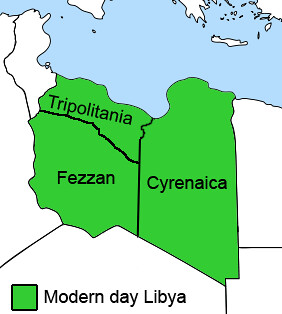Once pacification had been accomplished, fascist Italy endeavored to convert Libya into an Italian province to be referred to popularly as Italy's Fourth Shore. In 1934 Tripolitania and Cyrenaica were divided into four provinces--Tripoli, Misratah, Benghazi, and Darnah--which were formally linked as a single colony known as Libya, thus officially resurrecting the name that Diocletian had applied nearly 1,500 years earlier. Fezzan, designated as South Tripolitania, remained a military territory. A governor general, called the first consul after 1937, was in overall direction of the colony, assisted by the General Consultative Council, on which Arabs were represented. Traditional tribal councils, formerly sanctioned by the Italian administration, were abolished, and all local officials were thereafter appointed by the governor general. Administrative posts at all levels were held by Italians.
[. . .]
During the 1930s, impressive strides were made in improving the country's economic and transportation infrastructure. Italy invested capital and technology in public works projects, extension and modernization of cities, highway and railroad construction, expanded port facilities, and irrigation, but these measures were introduced to benefit the Italian-controlled modern sector of the economy. Italian development policy after World War I had called for capital-intensive "economic colonization" intended to promote the maximum exploitation of the resources available. One of the initial Italian objectives in Libya, however, had been the relief of overpopulation and unemployment in Italy through emigration to the undeveloped colony. With security established, systematic "demographic colonization" was encouraged by Mussolini's government. A project initiated by Libya's governor, Italo Balbo, brought the first 20,000 settlers--the ventimilli--to Libya in a single convoy in October 1938. More settlers followed in 1939, and by 1940 there were approximately 110,000 Italians in Libya, constituting about 12 percent of the total population. Plans envisioned an Italian colony of 500,000 settlers by the 1960s. Libya's best land was allocated to the settlers to be brought under productive cultivation, primarily in olive groves. Settlement was directed by a state corporation, the Libyan Colonization Society, which undertook land reclamation and the building of model villages and offered a grubstake and credit facilities to the settlers it had sponsored.
The Italians made modern medical care available for the first time in Libya, improved sanitary conditions in the towns, and undertook to replenish the herds and flocks that had been depleted during the war. But, although Mussolini liked to refer to the Libyans as "Muslim Italians," little more was accomplished that directly improved the living standards of the Arab population. Beduin life was disrupted as tribal grazing lands--considered underutilized by European standards but potentially fertile if reclaimed--were purchased or confiscated for distribution to Italian settlers. Complete neglect of education for Arabs prevented the development of professional and technical training, creating a shortage of skilled workers, technicians, and administrators that had not been alleviated in the late 1980s. Sanusi leaders were harried out of the country, lodges broken up, and the order suppressed, although not extinguished.
This photo post examining the hybridity of the homes built in Cyrenaica, in the east, to house the new Italian residents of confiscated Arab land is worth looking at. Gary Fowler's study of colonization in Tripolitania, the western Libyan region at the heart of modern Libya and the Italian colonial enterprise, is likewise worthwhile.

In Libya this week, it is said that the government is using mercenaries recruited from its various allies’ wars in sub-Saharan Africa as arseholes, and that it’s paying $500 a day for their services. Libyan per capita GDP is $14,884 at purchasing-power parity, so the price of privatised violence is running at a premium of over one hundred times typical earnings. Clearly, either the regime has so much less real legitimacy, or the degree of brutality required and risk involved is that much higher. In fact, those options are both consistent, as a regime with less legitimacy would need to use more force and it does seem to be doing just that.
I made the point last time out that it’s typical for mercenaries to be very highly paid relative to the countries in which they operate. This is clearly an important point here. It’s also true that Gadhafi’s Libya has often got other people to fight its battles for it – they exported Palestinians into a variety of different wars in the 1970s and 80s, notably sending PLO volunteers to prop up Idi Amin (you bet they didn’t sign on for that). Later, in the 1990s, they trained and equipped fighters in the various West African civil wars (notably Charles Taylor – there’s an arsehole for you). Now they’re doing the opposite.
Of course, being an oil state, they can probably afford to keep hiring the arseholes.




No comments:
Post a Comment